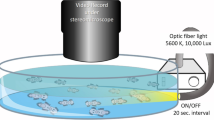Abstract
The parasitic dinophyte, Paulsenella sp., is attracted chemotactically by its host, the centric diatom Streptotheca thamesis. Seemingly rather short-lived components of the diatom mucilage are involved in the process. These components are presumably secreted by the Golgi apparatus and pass the thecal slit between epi-and hypocingulum. Experiments with concanavalin A indicate that glucose and-or mannose are constituents of the effective component, which is obviously not produced by egg cells, sperm cells and auxozygotes, since these stages do not attract the parasite. Plasmolysis inhibits secretion of the effective component. The readiness of the parasite to attack a host cell (its appetence) is light dependent: it is low in the dark period and increases after the beginning of the light period in cultures with a 14 h light/10 h dark regime. Endogenous rhythms of the parasite do not seem to be involved. In contrast, the attractiveness of the host is not influenced by the illumination.
Similar content being viewed by others
References
Donner, B., Rensing, L. (1984) Circadian control of chromosome unwinding and mitochondrial division in Gonyaulax polyedra. Eur. J. Cell Biol. 35, 143–145
Drebes, G. (1984) Life cycle and host specificity of marine parasitic dinophytes. Helgol. Wiss. Meeresunters. 37, 603–622
Drebes, G. (1985) Meiosis and resting cysts in the parasitic dinophyte Paulsenella Chatton. 2nd Int. Phycol. Congr., Copenhagen, Abstr., p. 39
Drebes, G., Schnepf, E. (1982) Phagotrophy and development of Paulsenella cf. chaetoceratis (Dinophyta), an ectoparasite of the diatom Streptotheca thamesis. Helgol. Wiss. Meeresunters. 35, 501–515
Evans, L.V., Callow, M.E., Callow, J.A., Bolwell, G.P. (1980) Egg-sperm recognition in Fucus. Br. Phycol. J. 15, 194–195
Fitt, W.K. (1985) Chemosensory responses of the symbiotic dinoflagellate Symbiodinium microadriaticum (Dinophyceae). J. Phycol. 21, 62–67
Hausmann, K. (1984) Die Dunkelfeld-Langzeitbelichtung: Eine Methode zur Darstellung schneller Bewegungsvorgänge. Mikrokosmos 73, 161–165
Hobohm, U., Cornelius, G., Taylor, W., Rensing, L. (1984) Is the circadian clock of Gonyaulax held stationary after a strong pulse of anisomycin? Comp. Biochem. Physiol. 79A, 371–378
Levandowsky, M., Hauser, D.C.R. (1978) Chemosensory responses of swimming algae and protozoa. Int. Rev. Cytol. 53, 145–210
Lombard, E.H., Capon, B. (1971) Observations on the tidepool ecology and behavior of Peridinium gregarium J. Phycol. 7, 188–194
Rosowski, J.R., Hoagland, K.D., Roemer, S.C. (1983) Valve and band morphology of some freshwater diatoms. IV. Outer suface mucilage of Navicula confervacea var. confervacea. J. Phycol. 19, 342–347
Schnepf, E., Deichgräber, G. (1984) “Myzocytosis”, a kind of endocytosis with implications to compartmentation in endosymbiosis. Observations in Paulsenella (Dinophyta). Naturwissenschaften 71, 218–219
Schnepf, E., Deichgräber, G., Drebes, G. (1985) Food uptake and the fine structure of the dinophyte Paulsenella sp., an ectoparasite of marine diatoms. Protoplasma 124, 188–204
Spero, H.J. (1985) Chemosensory capabilities in the phagotrophic dinoflagellate Gymnodinium fungiforme. J. Phycol. 21, 181–184
Spero, H.J., Morée, M.D. (1981) Phagotrophic feeding and its importance to the life cycle of the holozoic dinoflagellate Gymnodinium fungiforme. J. Phycol 17, 43–51
Stosch, H.A. von (1973) Observations on vegetative reproduction and sexual life cycles of two freshwater dinoflagellates, Gymnodinium pseudopalustre Schiller and Woloszynskia apiculata sp. nov. Br. Phycol. J. 8, 105–134
Sweeney, B.M. (1981) The circadian rhythms in bioluminescence, photosynthesis and organellar moyements in the large dinoflagellate Pyrocystis fusiformis. In: International cell biology 1980–1981, pp. 807–814, Schweiger, H.G., ed. Springer, Berlin Heidelberg New York
Author information
Authors and Affiliations
Rights and permissions
About this article
Cite this article
Schnepf, E., Drebes, G. Chemotaxis and appetence of Paulsenella sp. (Dinophyta), an ectoparasite of the marine diatom Streptotheca thamesis Shrubsole. Planta 167, 337–343 (1986). https://doi.org/10.1007/BF00391336
Received:
Accepted:
Issue Date:
DOI: https://doi.org/10.1007/BF00391336




